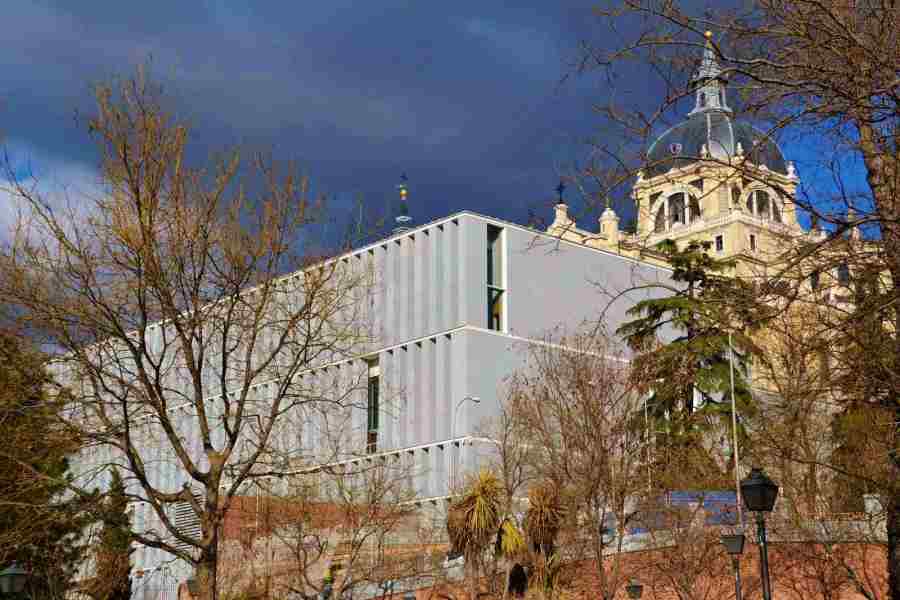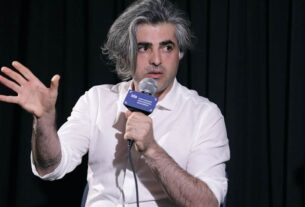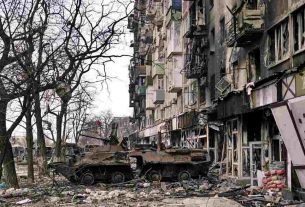![]() The park with the medieval wall with the Galeria de Colecciones Reales on the left and Almudena Cathedral on the right.
The park with the medieval wall with the Galeria de Colecciones Reales on the left and Almudena Cathedral on the right.
Fri 16 June 2023:
Drawing from the latest archaeological evidence, the museum endorses the narrative that Emir Muhammad I of Córdoba founded Madrid in the ninth century.
Madrid, Spain – A crucial part of Madrid’s Islamic heritage goes on display for the first time towards the end of this month as a new museum opens its doors to the public in the Spanish capital.
One of the star attractions of the Galeria de Colecciones Reales is part of Madrid’s original Umayyad fortified wall.
While the discovery of this medieval wall is not new, the language used to promote the exhibit signals that after years of vacillating, Spain’s capital is finally prepared to embrace its Muslim past.
Drawing from the latest archaeological evidence, the museum endorses the narrative – long widely accepted in academic circles – that Emir Muhammad I of Córdoba founded Madrid in the ninth century.
“Madrid is the only European capital with Islamic origins,” said Álvaro Soler, the archaeologist and curator responsible for the exhibit.
Soler added that this fact has long been an inconvenient truth: “When Felipe II decided to establish the capital in Madrid [in 1561], he was embroiled in religious wars against the Turks. He found himself facing the paradox that he was going to put the capital in a Muslim city. And that’s how the whole process of manipulating the city’s history began.”
The archaeological record reveals the true story.
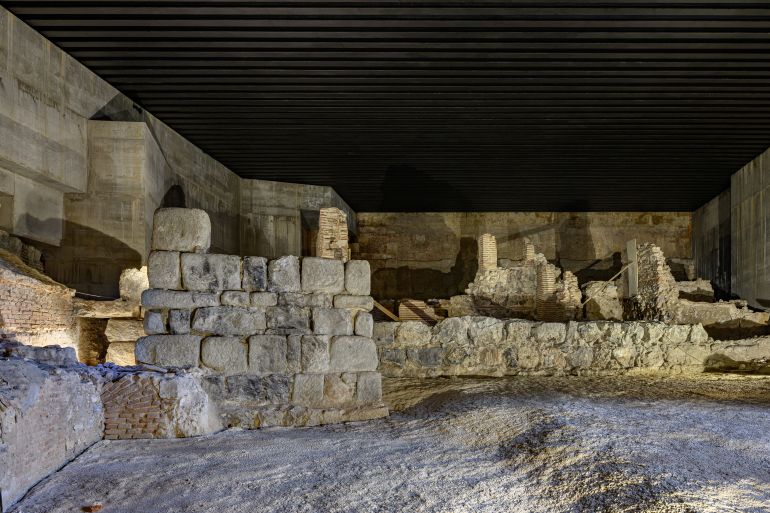
During the construction of the building in 1999, the wall and three towers were discovered along with the remains of a gate [Courtesy of Patrimonio Nacional]
The museum was built on the site of the original fortified wall right by Madrid’s Royal Palace, which itself sits on top of what was once the city’s alcázar (castle).
Right in the heart of the city, the area is rich with archaeological remains.
During the construction of the building in 1999, the wall and three towers were discovered along with the remains of a gate.
Archaeologists also uncovered numerous artefacts from the time when Madrid was known as Maŷrīṭ.
Visigoth skeleton
Nonetheless, Spain’s press was particularly fascinated by “Valentín”, an eighth-century skeleton found on the site in 2009.
In February 2011, chief archaeologist Esther Andréu explained to El País newspaper that this individual was probably a wandering Visigoth shepherd.
In June, newspapers El Mundo and ABC picked this story up with the headline “Visigoth skeleton casts doubt on the origins of Madrid”.
This was a huge reach: Andréu had not said the skeleton was evidence of a settlement.
Soler is annoyed this story is still being discussed. “We have the man in question in a box. But to be able to say that you have a Visigoth population in Madrid, you have to have a basilica or a cemetery or a church, something conclusive,” he says.
He pointed out that a single skeleton in the middle of what was once the countryside does not prove a thing. “The Visigoths are usually buried with grave goods and we have nothing.”
While the right-wing press misconstrued Andréu for a sensationalist headline, she still sticks to her claim that the skeleton was Visigoth citing the carbon dating of the corpse: “I don’t have any doubt. It’s from the eighth century.”
Daniel Gil, professor of Arabic and Islamic studies at Madrid’s Complutense University, countered that “technically, the Visigothic state disappeared with the Islamic conquest in the second decade of the eighth century”.
“In 712, the Muslims had already conquered Toledo and the surrounding region,” he said. “Although it is true that the Umayyad power took a long time to consolidate the area – that is why Madrid was founded – from 712 onwards we can no longer speak of Visigoths but of Andalusians, even if they were at odds with the emirs of Cordoba.”
Gil is committed to making sure citizens are aware of the city’s Islamic past and has worked with the Spanish non-profit organisation The Islamic Culture Foundation (FUNCI) on various projects, including the 2010 renovation of Parque Emir Mohamed I to ensure it had the correct vegetation from the time of al-Andalus – the Muslim-ruled area of the Iberian Peninsula.
History and political climate
The park sits right by the museum beneath another section of Madrid’s ninth-century wall that was discovered in the 1950s.
According to Gil, this wall has been, at times, treasured and often abandoned depending on the political climate. “When they inaugurated the park in the 90s, there were some very large plaques in Spanish and Arabic that paid homage to Muhammad I as the founder of Madrid. These plaques were removed when the park was renovated and are in a municipal warehouse. They [the city council] have never wanted to put them back.”
While there are some weather-worn plaques about Madrid’s Islamic heritage on the street close to the wall, there is nothing in the park itself.
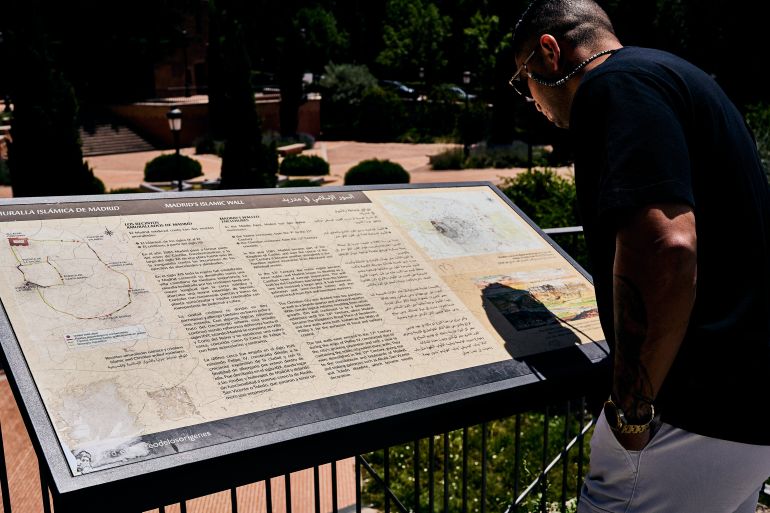
There are some weather-worn plaques about Madrid’s Islamic heritage on the street close to the wall [Felicity Hughes/Al Jazeera]
Gil also pointed out that the park is usually shut to the public: opening times are restricted to weekends and some entrances are even barred during these times.
Another curious decision made by the local government, this time the larger autonomous community of Madrid, is that any archaeological findings made within the city go to a museum about 40km (24 miles) away in Alcalá de Henares rather than the Museum of San Isidro in the city centre.
A strange choice seeing as the Museum of San Isidro is located where the city’s morería once stood – the area where Madrid’s Muslim community lived after the Christian conquest in 1083.
The museum’s director, Eduardo Salas, said: “There is a very nice piece that would really be my favourite, but the original is in Alcalá de Henares.”
The piece in question is a model of a city gate that might have been a toy or an incense burner.
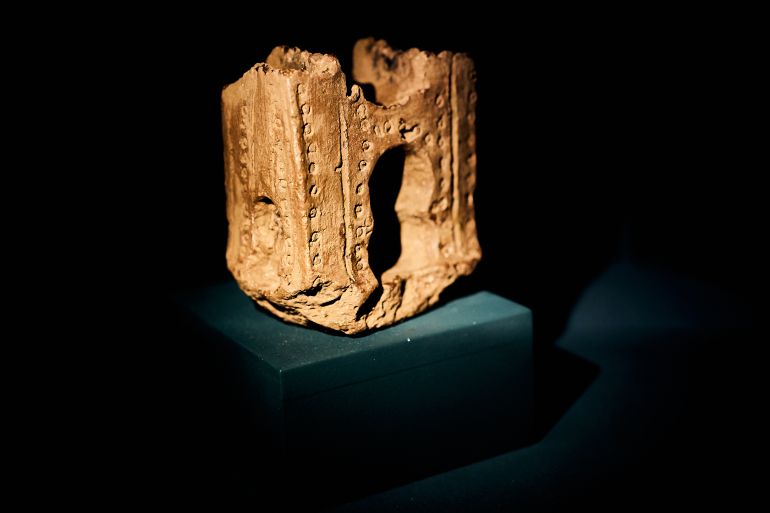
A model of a city gate that might have been a toy or an incense burner [Felicity Hughes/Al Jazeera]
“That piece appeared when excavations were made here in the museum,” Salas said. “The old Moorish door was right in front of the main door of the museum and this little model appeared here. While not necessarily the Moorish door, it is a model of an Islamic door, of an Islamic walled enclosure. But we have a reproduction. We would love to have the original.”
The Museum of San Isidro is dedicated to the origins of Madrid and has a fine if rather limited collection of Islamic ceramics.
Some of these artefacts come from a previous dig carried out when an underground car park was constructed in the 1990s by the Royal Palace under the Plaza de Oriente.
An 11th-century watchtower from the time of al-Andalus was also discovered at the time. While it is on display, it sits hidden within the car park without any signposting.
Gil thinks this is indicative of the uneasiness authorities have with admitting the Islamic origins of Madrid, which dates back to the study of medieval texts in the 19th and early 20th centuries.
“When the Arabic sources about the foundation of Madrid by Mohammed I were disseminated [in 1938], there was a widespread narrative officially, and in academic sectors as well, that is still alive today that, OK, Muhammad I founded the city of Madrid, but there was already a population of Visigoth origin, of Roman origin, or whatever,” Gil said.
“Then, as archaeology has progressed, it became clear that there are no traces prior to Islam in the historic centre of Madrid.”
The new museum
The display in the new museum is based on the latest available evidence.
In a huge room dedicated to remains found on site, visitors can hear about the city’s origins as one of a line of forts built to guard Toledo against attacks from the Christian north.
The video installation shows a 3D reconstruction of Maŷrīṭ and tells the story of Spain’s capital highlighting its origins as an Islamic outpost.
The Galería de las Colecciones Reales will be inaugurated by Spain’s king and queen on June 25 and will open its doors to the public on June 29.



